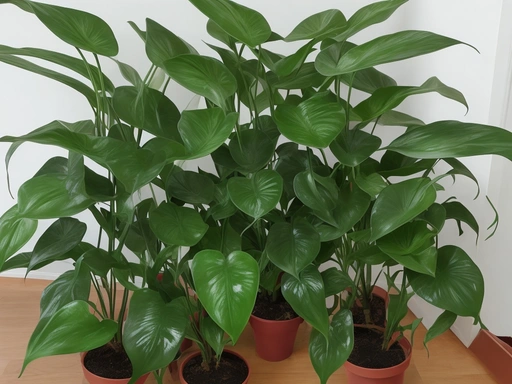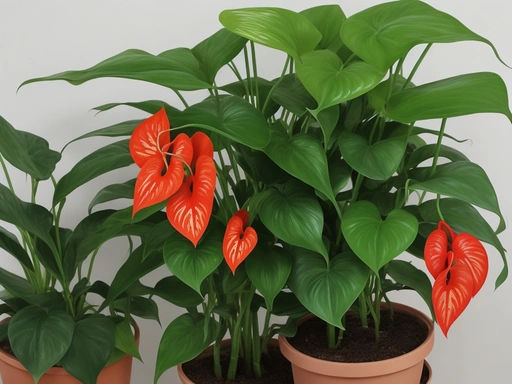Anthurium Plant Troubleshooting: Expert Tips!
Key Takeaways:
- Overwatering is a common mistake that can harm your Anthurium plant.
- Lack of humidity can cause browning of the plant’s leaves.
- Anthurium plants thrive in indirect, bright light conditions.
- Regular cleaning of the plant’s leaves can help prevent pests and diseases.
Are your Anthurium plants exhibiting signs of distress?
Don’t worry – I’ve got you covered! In this article, we’ll dive into the common issues that Anthurium plants face and how to troubleshoot them effectively.
From yellowing leaves to brown spots and wilting foliage, we’ll explore each problem, discuss their possible causes, and provide practical solutions.
With my expertise in plant care, you can confidently revive your Anthurium plants and help them thrive.
So, let’s roll up our sleeves and get ready to troubleshoot those green beauties!
| Problem | Possible Cause | Solution |
| Yellowing leaves | Overwatering | Reduce watering frequency and check soil moisture before watering |
| Brown leaf tips | Underwatering | Water the plant thoroughly and ensure proper drainage |
| Wilting leaves | Excessive heat or direct sunlight | Move the plant to a cooler and shadier location |
| Small, pale leaves | Insufficient light | Place the plant in a brighter location |
| Spots on leaves | Fungal or bacterial infection | Remove affected leaves and treat with a fungicide or bactericide |
Common Issues with Anthurium Plants
Anthurium plants can have common issues like yellowing leaves, insufficient light, overwatering, nutrient deficiency, brown spots, leaf spot disease, sunburn, water quality problems, wilting or drooping leaves, underwatering, overfertilizing, and root rot.
Yellowing Leaves
Yellowing leaves in anthurium plants can be caused by insufficient light, overwatering, or nutrient deficiency.
To address this issue, provide adequate light, adjust your watering routine, and address any nutrient deficiencies.
Insufficient Light
Insufficient light can cause yellowing leaves in Anthurium plants.
To remedy this, provide adequate light by placing your plant in a bright, indirect light location.
Avoid direct sunlight, as it can burn the leaves.
Consider using artificial grow lights if natural light is limited in your space.
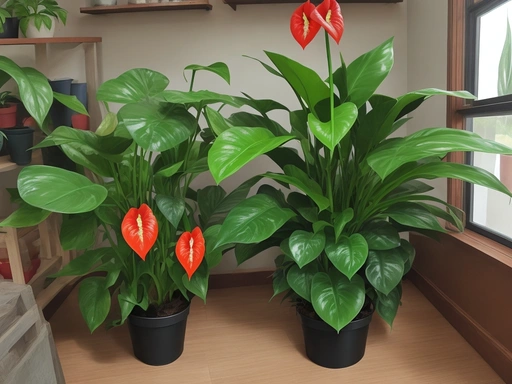
Overwatering
Overwatering is a common issue for Anthurium plants. It can lead to yellowing leaves, root rot, and ultimately, the death of the plant.
To avoid overwatering, make sure to let the soil dry out between waterings and only water when the top inch of soil feels dry to the touch.
It’s better to underwater than to overwater!
Nutrient Deficiency
Nutrient deficiency in anthurium plants can manifest as yellowing leaves, stunted growth, and overall poor plant health.
The most common deficiencies are nitrogen, phosphorus, and potassium.
To address this issue, you can use a balanced fertilizer specifically formulated for anthuriums.
Regularly feeding your plant with the right nutrients will help prevent deficiencies and promote healthy growth.
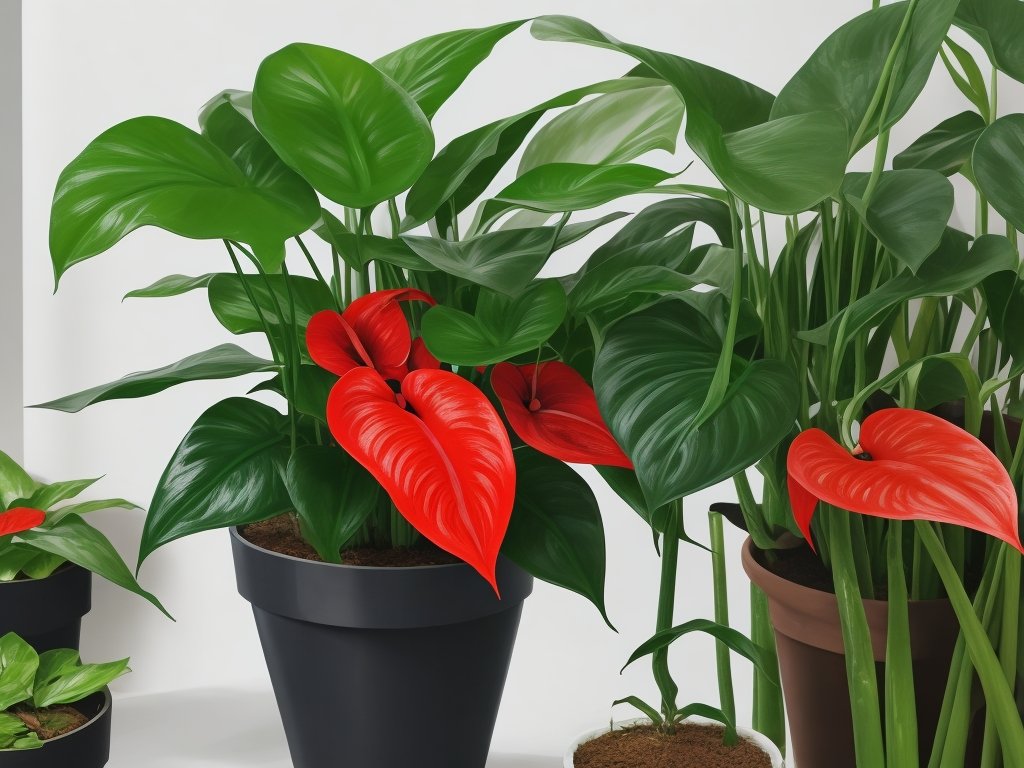
Brown Spots on Leaves
Brown spots on leaves in anthurium plants can be caused by leaf spot disease, sunburn, or water quality issues.
To treat them, remove affected leaves, control leaf spot disease, protect the plant from sunburn, and use filtered or purified water.
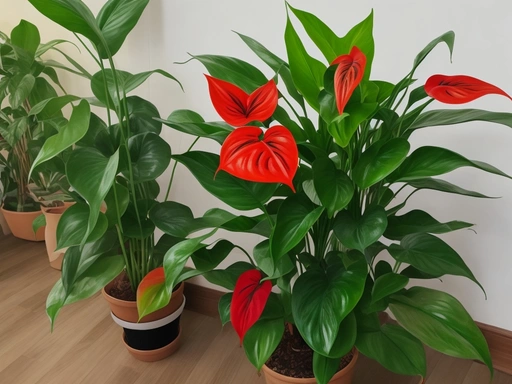
Leaf Spot Disease
Leaf spot disease is a common issue with Anthurium plants. It causes dark brown or black spots on the leaves.
To treat it, remove affected leaves, control the disease with fungicides, and protect the plant from sunburn and water quality issues.
Use filtered or purified water.

Sunburn
Sunburn occurs when anthurium plants are exposed to excessive sunlight. The leaves develop brown patches or turn yellow.
To address sunburn, move the plant to a location with indirect sunlight or use a sheer curtain to filter the light.
Ensure adequate shade during the hottest parts of the day.
Water Quality Issues
Water quality issues can cause brown spots on anthurium leaves.
To address this, use filtered or purified water for watering your plants.
Avoid using tap water, as it may contain chemicals and minerals that can harm your plant.
This simple change can help maintain healthy foliage.
Wilting or Drooping Leaves
Wilting or drooping leaves in anthurium plants can be caused by underwatering, overfertilizing, or root rot. Adjust your watering schedule, reduce fertilizer application, and treat root rot to remedy the issue.
Maintaining optimal growing conditions and good drainage can also help prevent wilting or drooping leaves.
Underwatering
Underwatering is a common issue with Anthurium plants. It occurs when the plant isn’t receiving enough water.
Signs of underwatering include wilting or drooping leaves.
To address this problem, adjust your watering schedule and make sure you are providing enough water to keep the soil moist, but not soggy.
Overfertilizing
Overfertilizing your Anthurium plant can lead to negative effects.
It can cause the leaves to turn yellow and the roots to burn.
To avoid overfertilizing, use a balanced fertilizer and follow the recommended dosage.
Don’t rush to add more fertilizer, as your plant may not need it.
Pay attention to your plant’s needs and adjust accordingly.
Root Rot
Root rot is a common issue that affects Anthurium plants.
It occurs when the roots are overwatered and become waterlogged, leading to fungal infection and decay.
Signs of root rot include wilting or drooping leaves, yellowing foliage, and a foul odor from the soil.
To treat root rot, remove the affected plant from its pot, trim away any rotting roots, and repot it in fresh, well-draining soil.
Adjust your watering routine to prevent overwatering and ensure the plant has proper drainage.
Solutions for Yellowing Leaves in Anthurium Plants
To address yellowing leaves in your Anthurium plants, ensure they receive adequate light and adjust your watering routine. Additionally, address any potential nutrient deficiencies.
Provide Adequate Light
Anthurium plants require bright, indirect light to thrive. Place them near a window with filtered sunlight or use artificial grow lights.
Avoid direct sunlight, as it can burn the leaves.
If your Anthurium is not getting enough light, move it to a brighter location and watch its leaves regain their healthy green color.
Adjust Watering Routine
To adjust your watering routine for your Anthurium plant, make sure you’re not over or under watering it. Allow the top inch of the soil to dry out before watering again.
Avoid leaving the plant in standing water, as it can lead to root rot.
Regularly check the moisture levels of the soil to ensure you’re providing the right amount of water.
Address Nutrient Deficiency
To address nutrient deficiency in your Anthurium plant, you can use a balanced fertilizer specifically designed for houseplants.
Look for one with equal amounts of nitrogen, phosphorus, and potassium.
Follow the package instructions for application rates and frequency.
Additionally, consider adding organic matter or compost to enrich the soil and provide essential nutrients.
How to Treat Brown Spots on Anthurium Leaves
To treat brown spots on Anthurium leaves, you can start by removing the affected leaves.
Additionally, controlling leaf spot disease, protecting the plant from sunburn, and using filtered or purified water can be helpful.
Remove Affected Leaves
To remove affected leaves from your Anthurium plant, simply use sharp, clean scissors or pruners to cut them off at the base.
Make sure to dispose of the leaves properly to prevent the spread of any diseases or pests.
Regularly inspect your plant for any new affected leaves and remove them promptly to maintain a healthy plant.
Control Leaf Spot Disease
To control leaf spot disease on your Anthurium plant, start by removing and discarding any affected leaves.
Then, make sure the plant is receiving the proper amount of light, water, and nutrients.
Avoid overwatering and provide good air circulation.
Consider applying a fungicide if the problem persists.
Protect the Plant from Sunburn
To protect your Anthurium plant from sunburn, make sure to place it in a location where it receives bright, indirect light. Avoid placing it in direct sunlight, especially during the hottest parts of the day.
You can also provide some shade with curtains, blinds, or sheer fabric if necessary.
Regularly monitor the leaves for any signs of sunburn and adjust the plant’s position accordingly.
Use Filtered or Purified Water
Use filtered or purified water for your Anthurium plant to prevent water quality issues.
Tap water may contain chemicals or minerals that can harm the plant and cause brown spots on the leaves.
Filtering or purifying the water removes these impurities, ensuring a healthier growing environment for your Anthurium.
Remedies for Wilting or Drooping Anthurium Leaves
If you notice wilting or drooping Anthurium leaves, try adjusting your watering schedule and reducing fertilizer application. Another possible remedy is treating root rot.
Adjust Watering Schedule
Adjusting the watering schedule is important for maintaining the health of your Anthurium plant.
To do so, consider the current watering routine and adjust accordingly based on the condition of the soil.
Allow the top inch of soil to dry out before watering again.
Ensure that the pot has adequate drainage to prevent waterlogged roots.
Reduce Fertilizer Application
To reduce fertilizer application for your Anthurium plant, follow these steps:
- Use a balanced fertilizer: Switch to a fertilizer with a lower nitrogen content, as excessive nitrogen can lead to leaf wilting.
- Dilute the fertilizer: Mix the fertilizer with water at a lower concentration than recommended on the label. This will provide nutrients without overwhelming the plant.
- Apply fertilizer less frequently: Instead of fertilizing every time you water, reduce the frequency to once every 4-6 weeks. This will prevent overfertilization.
- Monitor the plant’s response: Observe the plant for signs of wilting or nutrient deficiency. If the leaves start to droop, adjust the fertilizer application accordingly.
Remember, less is more when it comes to fertilizing your Anthurium plant.
By reducing the application, you can help prevent wilting and promote healthier growth.
Treat Root Rot
To treat root rot in an Anthurium plant, you should take the following steps:
- Remove the affected parts: Carefully trim away any brown or mushy roots and discard them. This will prevent further spread of the disease.
- Improve drainage: Make sure your plant is in well-draining soil and avoid overwatering. Allow the top inch of soil to dry out before watering again.
- Adjust watering routine: Water your plant only when the top layer of soil feels dry to the touch. Overwatering is a common cause of root rot, so be cautious.
- Use a fungicide: If the root rot is severe, you can treat it with a fungicide specifically designed for this purpose. Follow the instructions on the product carefully.
Remember, addressing root rot promptly is crucial for the health of your Anthurium plant.
Taking these steps should help your plant recover and thrive.
Prevention and Maintenance Tips for Healthy Anthurium Plants
To keep your Anthurium plants healthy, it’s important to provide optimal growing conditions and maintain good drainage.
Additionally, regular monitoring and pest control will help to prevent issues and maintain their vitality.
Provide Optimal Growing Conditions
To provide optimal growing conditions for your Anthurium plant, consider the following factors:
- Light: Place your plant in an area with bright, indirect sunlight. Avoid direct sunlight as it can cause sunburn.
- Watering: Water your Anthurium plant thoroughly but allow the top inch of soil to dry before watering again. Overwatering can lead to root rot.
- Temperature and Humidity: Anthurium plants prefer temperatures between 60-85°F (15-29°C and humidity levels of 60-80%. Avoid extreme temperature fluctuations.
- Good Drainage: Ensure your plant’s pot has drainage holes to prevent waterlogging.
- Pest Control: Regularly monitor and control pests like aphids and spider mites to keep your Anthurium plant healthy.
Light Requirements
Anthurium plants thrive in bright, indirect light. They prefer bright, but not intense, sunlight.
Place them in a location with filtered or dappled sunlight, like near a north or east-facing window.
Avoid placing them in direct sunlight as it can burn their leaves.
Watering Guidelines
Watering your Anthurium plant can be a bit tricky, but with some guidelines, it’s easier to keep your plant happy and healthy.
Here are a few watering tips to keep in mind:
- Check the soil moisture: Before watering, check the top inch of the soil. If it feels dry, it’s time to water. If it’s still moist, wait a bit longer.
- Water thoroughly: When watering, make sure to water the plant until the water drains out of the bottom of the pot. This helps ensure that the roots get enough water and prevents waterlogged soil.
- Avoid overwatering: Anthuriums prefer slightly moist soil, not soggy conditions. Overwatering can lead to root rot and other problems. Allow the soil to dry slightly between waterings.
- Consider the environment: The watering needs of your Anthurium may vary depending on factors like temperature and humidity. In warmer and drier conditions, the plant may need more frequent watering.
Temperature and Humidity
The ideal temperature range for Anthurium plants is between 60°F (15°C) and 85°F (29°C).
They prefer a warm environment, but can tolerate temperatures as low as 50°F (10°C) for short periods.
As for humidity, Anthuriums enjoy high humidity levels between 60% and 80%.
Mist the leaves regularly to increase humidity, or place the plant on a tray with water and pebbles to create a humid microclimate.
Maintain Good Drainage
To maintain good drainage for your Anthurium plant, it’s important to choose a well-draining potting mix and a pot with drainage holes.
Avoid overwatering and make sure excess water can easily escape from the pot.
Placing pebbles or gravel at the bottom of the pot can also help improve drainage.
Regularly Monitor and Control Pests
Regularly monitoring and controlling pests is essential for the health of your Anthurium plants.
Here are some steps you can take:
- Inspect your plants regularly for signs of pests such as aphids, mealybugs, or spider mites.
- If you spot any pests, remove them manually or use natural insecticidal soap to control their population.
- Keep an eye out for any unusual spots or markings on the leaves, as these can indicate the presence of pests or diseases.
- Prevent pests from spreading by quarantining any new plants before introducing them to your Anthurium collection.
- Maintain good hygiene by regularly cleaning your plants and removing any dead or decaying foliage.
help ensure the well-being of your Anthurium plantsainst pests, you can help ensure the well-being of your Anthurium plants.
Frequently Asked Questions
Why are my Anthurium leaves turning yellow?
There are a few possible reasons for Anthurium leaves turning yellow, including insufficient light, overwatering, and nutrient deficiency. Make sure your plant is getting enough light, adjust your watering routine, and address any nutrient deficiencies to help keep your Anthurium happy and healthy.
How often should I water my Anthurium plant?
Water your Anthurium plant when the top inch of soil feels dry. Stick your finger into the soil to check its moisture level.
Be cautious not to overwater, as Anthuriums are susceptible to root rot.
Ensure the pot has good drainage to prevent waterlogging.
What is the ideal temperature range for Anthurium plants?
The ideal temperature range for Anthurium plants typically falls between 70 to 90 degrees Fahrenheit (21 to 32 degrees Celsius).
These tropical plants thrive in warm environments, so it’s important to keep them away from drafts or extreme temperature fluctuations.
Maintaining a consistent temperature within this range will help your Anthurium plants flourish.
Final Verdict
The key to troubleshooting common issues with Anthurium plants is understanding their specific needs.
Yellowing leaves can be addressed by providing sufficient light, adjusting watering routines, and addressing nutrient deficiencies.
Brown spots can be treated by removing affected leaves, controlling leaf spot disease, protecting the plant from sunburn, and using filtered or purified water.
Wilting or drooping leaves can be remedied through adjusting watering schedules, reducing fertilizer application, and treating root rot.
To maintain healthy Anthurium plants, provide optimal growing conditions, maintain good drainage, and regularly monitor and control pests.
By following these guidelines, you can ensure that your Anthurium plants thrive and bring beauty to your space.


